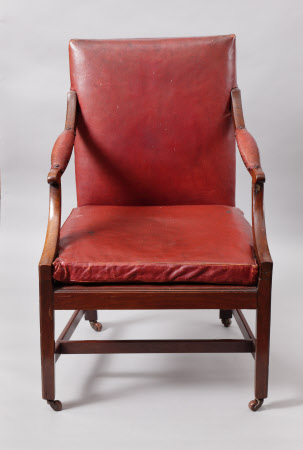Open armchair
possibly Gillows of Lancaster
Category
Furniture
Date
circa 1760
Materials
Solid mahogany, rush seats, leather (calfskin) and Rexine upholstery, later ceramic and brass castors
Measurements
92 x 60.5 x 51.5 cm
Place of origin
Lancaster
Order this imageCollection
Sizergh Castle, Cumbria
NT 998197.3
Summary
A mahogany open armchair, one of an unusual set of six mahogany and rush-seated open armchairs, English, circa 1760, possibly by Gillows of Lancaster. NT 998197.1 - 4 upholstered in red calfskin, NT 998197.5 - 6 in 19th century yellow and white-striped silk. With straight toprail, and two ladder-type splats beneath the upholstery. The unusually highly-set arms on downswept partly padded and upholstered arms on incurved arms supports either side of a loose seat cushion above a mahogany-framed rush seat, with exposed front seat rail. On square-section legs united by an 'H'-shaped stretcher and a rear stretcher, and on castors. Some retaining their original leather castors.
Full description
A mahogany open armchair, one of an unusual set of six mahogany and rush-seated open armchairs, English, circa 1760, possibly by Gillows of Lancaster. NT 998197.1 - 4 upholstered in red calfskin, NT 998197.5 - 6 in 19th century yellow and white-striped silk. With straight toprail, and two ladder-type splats beneath the upholstery. The unusually highly-set arms on downswept partly padded and upholstered arms on incurved arms supports either side of a loose seat cushion above a mahogany-framed rush seat, with exposed front seat rail. On square-section legs united by an 'H'-shaped stretcher and a rear stretcher, and on castors. Some retaining their original leather castors. The chairs in this set are numbered - this example is marked to the right seat rail with a '1' - and some are signed 'Rush' a reference perhaps to the fact that the seats are made of rush. This is an unusual feature and it is not clear whether these chairs were originally rush-seated ladderbacks which have been later upholstered, or whether the ladder splats are in fact merely constructional. The timber is fine quality, as are the remaining leather castors. These chairs may have been supplied by Gillows of Lancaster to Sizergh in the 1760s. We know that seven chairs were made for Charles Strickland in February 1765 by William Taylor. And in 1766, another seven chairs were made for Mr. Strickland by John Pembleton. Eight plain chairs were also made for Mr Strickland in February 1766. Both sets resemble a faint pencil sketch of a 'French' armchair made by Robert Townson for Gillows in 1761, which like this set of six chairs 'has the same kind of sloping arms as those at Sizergh.' This very plain type of chair was called 'French' by the Gillows firm at this period, even though they tended to be plain, with simple arms and square-section legs embellished only by a moulding or chamfer and castors.
Provenance
Given by Henry Hornyold Strickland (1890 – 1975) with Sizergh Castle and its estates in 1950.
Credit line
Megan Wheeler
Marks and inscriptions
Inside right seat rail: '1'
Makers and roles
possibly Gillows of Lancaster , cabinetmaker
References
Stuart, Susan 'Gillows of Lancaster and London 1730 - 1840' (2008) 2 vols., Volume I, p. 146
